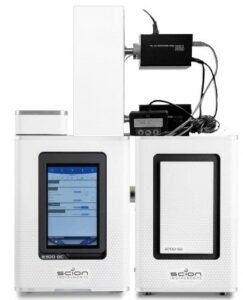Detection of toxic organic compounds in ambient air is undoubtedly one of the most difficult analyses in gas chromatography. Samples must be concentrated into a small volume to enhance detection. A very large number of possible organics (>300) must be “fully” resolved to avoid improperly assigning concentrations from overlapping peaks.
Official methods for this analysis include US EPA TO-15 and California Air Resources Board SOP MLD058.
Air Scion – 8300/8700 Scion GCMS

The Air Scion from Lotus Consulting provides impressive separations and detection of trace volatile organics in ambient air samples. The system features the Scion 8300/8700 Gas Chromatograph with built-in high performance sample concentrator and the Scion Single Quadrupole Mass Spectrometer.
This system handles both pressurized canisters and Tedlar bags without hardware changes. It also meets the exacting requirements for the US EPA TO-15 implementation for speciation of toxic compounds and the California Air Resources Board SOP No. MLD058 for determination of toxic organic compounds in ambient air.
The fully automated system is designed to completely resolve nearly all volatile organics from Freons to Hexachlorobutadiene down to levels typically below 0.008 ppb V/V (300 ml injection). Samples are loaded through a 16-position automated sampler and trapped onto a low-volume adsorbent trap, with a mass flow controller (MFC) setting the sample size. A secondary cryofocus trap reduces the sample components to a smaller volume for injection into the column.
The system typically involves an adsorbent trap, a cold trap, at least 4 automated valves, 16- or 31-position automated sampler, and one workstation. All of these operations utilize nearly all of the powerful and comprehensive capabilities of the Scion 8300/8700 GCMS and Scion MS Workstation. Such a complex analyzer requires assurances that the data is valid, that the system is fully functional and easy to use, and that the ultimate performance is achievable.
